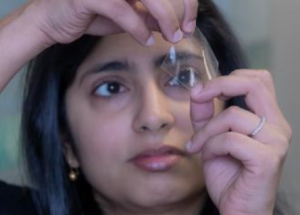
In the era of advanced intelligent systems, people always like the cold vocabulary of machines. They have no perception, human feelings, and no thinking. This is the biggest difference between humans and robots. So far, there has not been a machine with human perception in the world .

Maybe you will say “Don’t put my seventh brother in your eyes!” Yes, the robot “Seventh Brother” in the Indian sci-fi blockbuster “Bollywood Robot Love” released in 2010 not only possesses human wisdom, but also produces Hormones are no different from humans in appearance and mentally perfect. However, a machine is always a machine. It has a fatal flaw. There is no pain caused by human skin irritation, and there is no feeling when touching things, which is impassable gulf between machine and human beings.

Recently, Australian scientists have developed a touch and sensory electronic skin. This system simulates the way of humans transmit information through the nervous system, and transmits the information received by the skin to the nerve center. Pain, temperature and pressure are perceived when pressure and temperature reach painful thresholds.

On September 1, the research results of the team entitled Artificial Somatosensors: Feedback Receptors for Electronic Skins (Artificial body sensor: feedback receptor of electronic skin)were published in the journal Advanced Intelligent Systems(Advanced Intelligent Systems). The R&D team has applied for a provisional patent. In the paper, the R&D team mainly showed three key points of electronic skin, the ring corpuscles, thermal receptors and pain receptors.

The so-called ring corpuscles are the cells that exist in the human body to help humans feel the sense of pressure and vibration, combined with previous development and creative and obtained three patented technologies:
Stretchable electronic products: Combining oxide materials with biocompatible silicones can provide transparent and robust wearable electronic products, those are only as thick as a sheet of paper.
2.Temperature-responsive coating: A coating that is 1,000 times thinner than a human hair, which is made of a material that can react to temperature.
3.Electronic cells that imitate brain memory: can imitate long-term brain memory, recall and retain previous information.
It is not difficult to see that this is a technology that mimics human cell activity and the working principle of neural networks, and can feel pain, temperature and pressure.

For a long time, human beings have been persevering on the road of relieving and alleviating pain. On the one hand, the feeling of pain makes people miserable, especially during injuries or surgery; on the other hand, pain is also a warning when encountered feeling painful, you can respond to the environment based on feedback, stop the loss in time and protect yourself.
The research team stated that the manufacturing process does not require separate, complex thermoelectric modules or piezoelectric pressure sensors for the actual translation of the concept body sensor. So, how does the electronic skin feel the stimulus or make response?
Working principle of electronic skin
Part a of the figure below shows the three receptors receiving stimuli: the receptors are connected to the spinal cord through the posterior horn of gray matter, and the spinal cord transmits information to the brain. There are two channels for information transmission, which are used for pressure detection (blue part) and temperature detection (red part), when pressure, temperature or pain reaches a set threshold, the storage units of the three sensors will trigger a response.
For each receptor specifically, when the toroidal corpuscles are not stimulated, both circuits have medium currents (part b);
When the toroidal body is under pressure, a significant large current passes through the memristor (part c) .
No temperature is applied, no current flows on the thermal receptors and pain receptors through the memristor (part d);
When temperature is applied, thermal receptors and pain receptors will trigger conductive filaments in the memristor, and generating large currents (part e).

Pain is triggered when the electronic skin’s perception of the outside world reaches a threshold of temperature and pressure.
Ataur Rahman, MD, the research team said, “It is subtle enough to convey the difference between poking oneself lightly with a pin and poking hard.” Electronic skin is very close to traditional human skin in terms of shape and performance. Its appearance will be a huge breakthrough in medical technology and science and technology.
Electronic skin will be the role of eyes for humans in the repair and replacement of prosthetic limbs and traditional skin. In terms of prosthetics, imitating the touch of human skin will make special people more confident in grabbing things and walking more easily.
The key is to give them a new touch ability to judge more accurately what is an iron ball and what is a flower, and improve the awareness of physical touch to the dangers of the outside world. On the other hand, when the traditional skin is damaged too much and needs to be repaired, the electronic skin can be implanted non-invasively in the future while simulating the working principle of traditional skin. The significance in this respect is self-evident.

Electronic skin still has a long way to go in the future. Whether it is invasive implantation to replace traditional skin or to trigger prosthetic sensations, it cannot be used in large-scale clinical applications at this stage. Human beings have always contradicted the progress of intelligent robots, eager to create machines with human form and wisdom, and fear that machines will counteract humans. We are eager to an ecological balance between technology and humans.
Comments